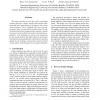Free Online Productivity Tools
i2Speak
i2Symbol
i2OCR
iTex2Img
iWeb2Print
iWeb2Shot
i2Type
iPdf2Split
iPdf2Merge
i2Bopomofo
i2Arabic
i2Style
i2Image
i2PDF
iLatex2Rtf
Sci2ools
HAPTICS
2005
IEEE
2005
IEEE
Bow Spring/Tendon Actuation for Low Cost Haptic Interfaces
This paper describes a novel bow spring and tendon actuator design for a haptic interface that provides highbandwidth force transmission to the fingers, with a large range of motion. This is combined with a low-cost stepper motor and a low-cost optical encoder, along with selfcalibration and control compensation to produce a smooth force source with excellent hard virtual wall rendering capabilities. Four techniques are discussed to compensate for bow spring, friction, and ripple torques in the actuator. Experimental results quantify the achieved force rendering quality of each technique, and provide a measure of hard virtual surface rendering quality in one degree of freedom.
| Added | 24 Jun 2010 |
| Updated | 24 Jun 2010 |
| Type | Conference |
| Year | 2005 |
| Where | HAPTICS |
| Authors | Dale A. Lawrence, Lucy Y. Pao, Sutha Aphanuphong |
Comments (0)

